
-
 History of Religions
History of the 3 Monotheistic religions (Judaism, Christianity and Islam) and of the main different Christianity confessions (Roman Catholicism, Eastern Catholicism and Eastern Orthodoxy, Anglicanism and Protestantism)
History of Religions
History of the 3 Monotheistic religions (Judaism, Christianity and Islam) and of the main different Christianity confessions (Roman Catholicism, Eastern Catholicism and Eastern Orthodoxy, Anglicanism and Protestantism)
-
 Pedagogical Approaches
New pedagogical approaches to teach history of religion
Pedagogical Approaches
New pedagogical approaches to teach history of religion
-
 Role of Religions in Civilization
How to didactically promote among students of different confessions, the capacity of a critical analysis and understanding of the role played by religions in the history of mankind
Role of Religions in Civilization
How to didactically promote among students of different confessions, the capacity of a critical analysis and understanding of the role played by religions in the history of mankind
-
 Interreligious Students’ Competences
Set of teaching contents, to be used by teachers to highlight and valorize the universal values of tolerance and universalisms that all Monotheistic religions and religious texts contain to promote and sustain mutual understanding among students
Interreligious Students’ Competences
Set of teaching contents, to be used by teachers to highlight and valorize the universal values of tolerance and universalisms that all Monotheistic religions and religious texts contain to promote and sustain mutual understanding among students
-
 Managing Multi-Religious Classes
Teaching Sources to help teachers dealing with multicultural and multi-religious classes
Managing Multi-Religious Classes
Teaching Sources to help teachers dealing with multicultural and multi-religious classes
-
 Introduction
A comparative review of the liturgical celebrations, ceremonies and dietary rules existing in the different religions.
Introduction
A comparative review of the liturgical celebrations, ceremonies and dietary rules existing in the different religions.
-
 Celebrations
Description and comparative analysis of the celebrations of different religions and confessions
Celebrations
Description and comparative analysis of the celebrations of different religions and confessions
-
 Ceremonies
Description and comparative analysis of the ceremonies of different religions and confessions
Ceremonies
Description and comparative analysis of the ceremonies of different religions and confessions
-
 Dietary Rules
Description and comparative analysis of the dietary rules of different religions and confessions
Dietary Rules
Description and comparative analysis of the dietary rules of different religions and confessions
Events
The Pathway through Religions project has been promoted trough conferences and articles.
Partnership
-
 Contractual Partners
From this section it is possible to access to a description of each contractual partner of the Pathway through Religions project.
Contractual Partners
From this section it is possible to access to a description of each contractual partner of the Pathway through Religions project.
-
 Schools
From this section it is possible to access to the information about the schools involved in the Pathway through Religions Project in the European countries involved.
Schools
From this section it is possible to access to the information about the schools involved in the Pathway through Religions Project in the European countries involved.
-
 Associated Partners
As a result of the exploitation activity a number of associated partners officially joined the project in order to contribute to the improvement of the project impact on their target groups and to ensure the project sustainability by continuing using the project deliverables in the next years.
Associated Partners
As a result of the exploitation activity a number of associated partners officially joined the project in order to contribute to the improvement of the project impact on their target groups and to ensure the project sustainability by continuing using the project deliverables in the next years.
This section of the Pathway through Religions portal provides administrative information for the project contractual partners and for the European Commission and it is password protected.
Ceremonies
Homepage > Training Course > Ceremonies

Description and comparative analysis of the ceremonies of different religions and confessions
Cerimonies
At the Last Supper, Jesus is the “host” and the apostles the “guests”. Washing the feet of weary travelers was a job delegated to a non-Jewish slave by the host. Not even a Jewish slave would be expected to wash feet. The host of a meal would certainly not lower himself to performing this vile task himself. The feet of travelers in ancient Palestine were shod in sandals, and thus filthy from traveling on dirt roads. However, as St. Paul says: «Christ Jesus, who though he was in the form of God, did not count equality with God a thing to be grasped, but emptied himself, taking the form of a servant» (Phil. 2,5-7) Jesus himself tells us that the «first shall be last», (Matt. 20,16) and in the washing of the feet he shows his willingness to take on the work of the last and the least.
The reason Jesus washes his disciples' feet is to offer them an example to follow. They are to embrace humility at all times, and to serve one another. As St. Augustine writes: «as [man] was lost by imitating the pride of the deceiver, let him now, when found, imitate the Redeemer’s humility».
The rite is performed by the priest during the celebration of the mass In Coena Domini. In 2014 Pope Francis has issued a decree revising the rules for the traditional foot-washing ritual on Holy Thursday, saying the rite should no longer be limited to men and boys, but also include women and young girls. Those participating in the ceremony, the decree says, should be representative of the entire community. The change, Francis wrote, is «an attempt to improve the method of implementation, to express the full meaning of the gesture performed by Jesus at the Last Supper, his gift of himself ‘to the end’ for the salvation of the world, his boundless charity».
Explaining the meaning of this ceremony, the Pope said: «The Upper Room speaks to us of service, of Jesus giving the disciples an example by washing their feet. Washing one another’s feet signifies welcoming, accepting, loving and serving one another. It means serving the poor, the sick and the outcast, those whom I find difficult, those who annoy me».
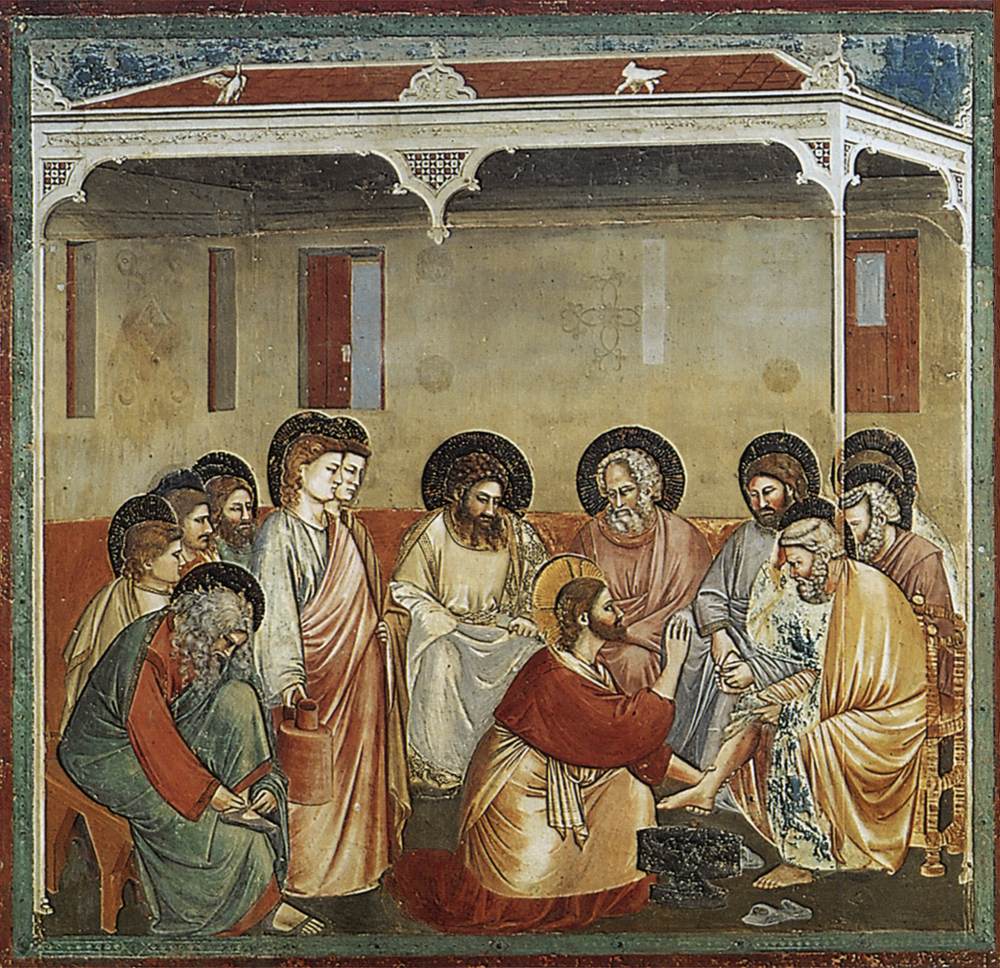
GIOTTO, Christ Washing the Disciples' Feet, Padua, Scrovegni Chapel, 1303-1305
After the scene of Judas' Betrayal on the triumphal arch wall, the story continues on the tier below, on the window-side (right side) of the chapel. Here we have a symmetrical arrangement (an outdoor scene flanked by two indoor scenes) of scenes from the Passion of Christ - the Last Supper, the Washing of Feet, the Kiss of Judas, Christ before Caiaphas, and the Flagellation. The details are very accurate, especially the intensity of the exchange of glances between Jesus and Peter.
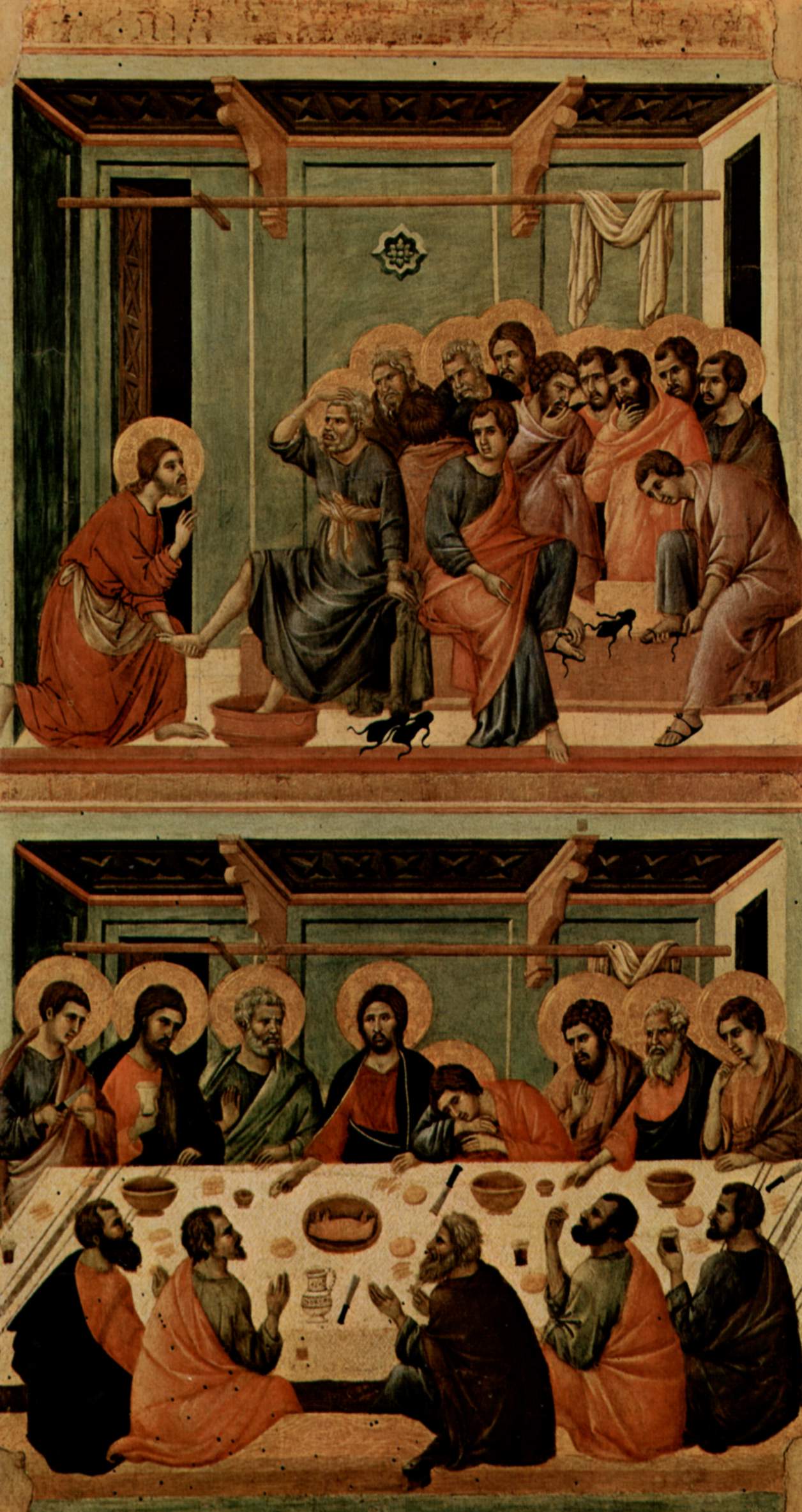
DUCCIO DI BUONINSEGNA, Last Supper and the Washing of the feet, Siena, Museo dell’Opera Metropolitana del Duomo, 1308-1311
The washing of the feet and the Last Supper is an autograph painting by Duccio di Buoninsegna belonging to the main register of the Maestà of the Duomo of Siena. The two representations are painted on a single panel to represent the two themes that, in their unity, constitute the heart of Holy Thursday. The Washing of the Feet is told only in St John's Gospel.
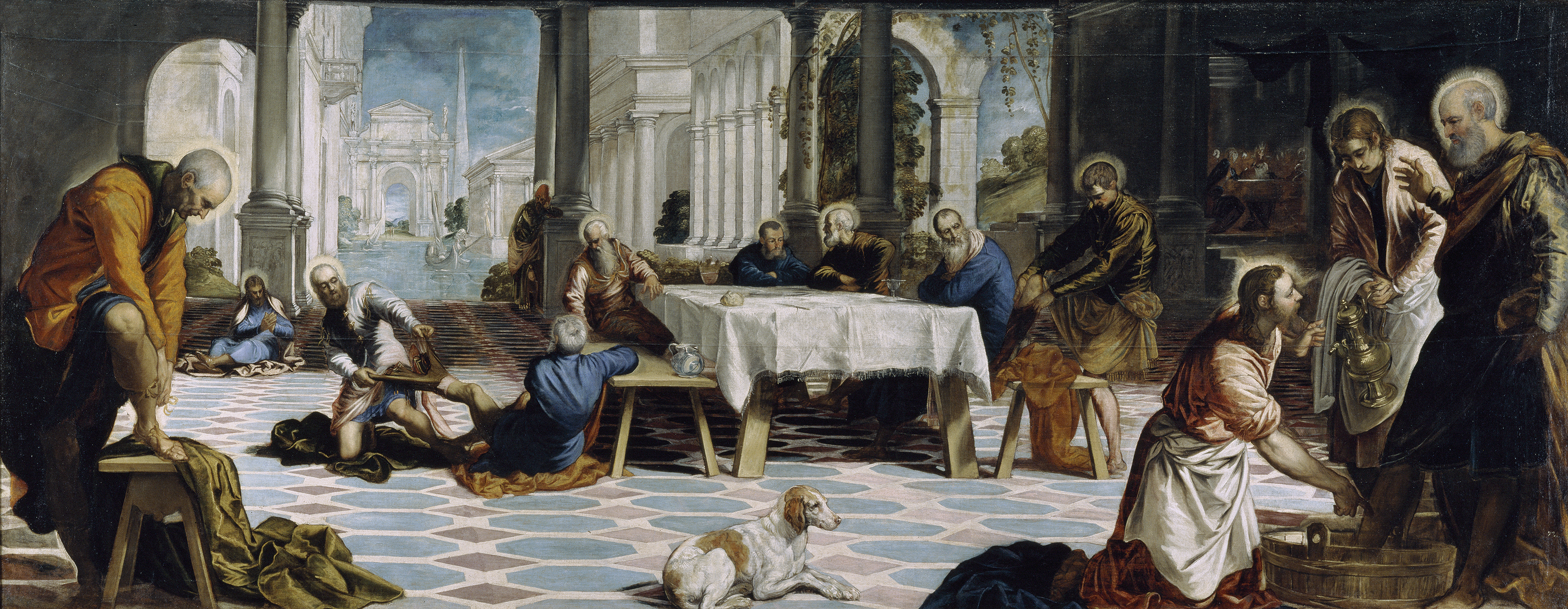
JACOPO COMIN called TINTORETTO, Christ Washing the Disciples' Feet, Madrid, Prado Museum, 1548-1549
Christ Washing the Disciples' Feet was a favourite theme of Tintoretto and there are at least six known works by him on the subject. This story from the New Testament (John 13,1-20) called for a complex image with many characters in a variety of poses and motions, and the diversity and challenge attracted Tintoretto. When seen from the right, the painting is extraordinarily coherent. The dead spaces among the characters disappear and the composition appears ordered along a diagonal that begins with Christ and Saint Peter and continues along the table and the Apostles around it, to end at the Arch behind the canal, which is the work´s true vanishing point.
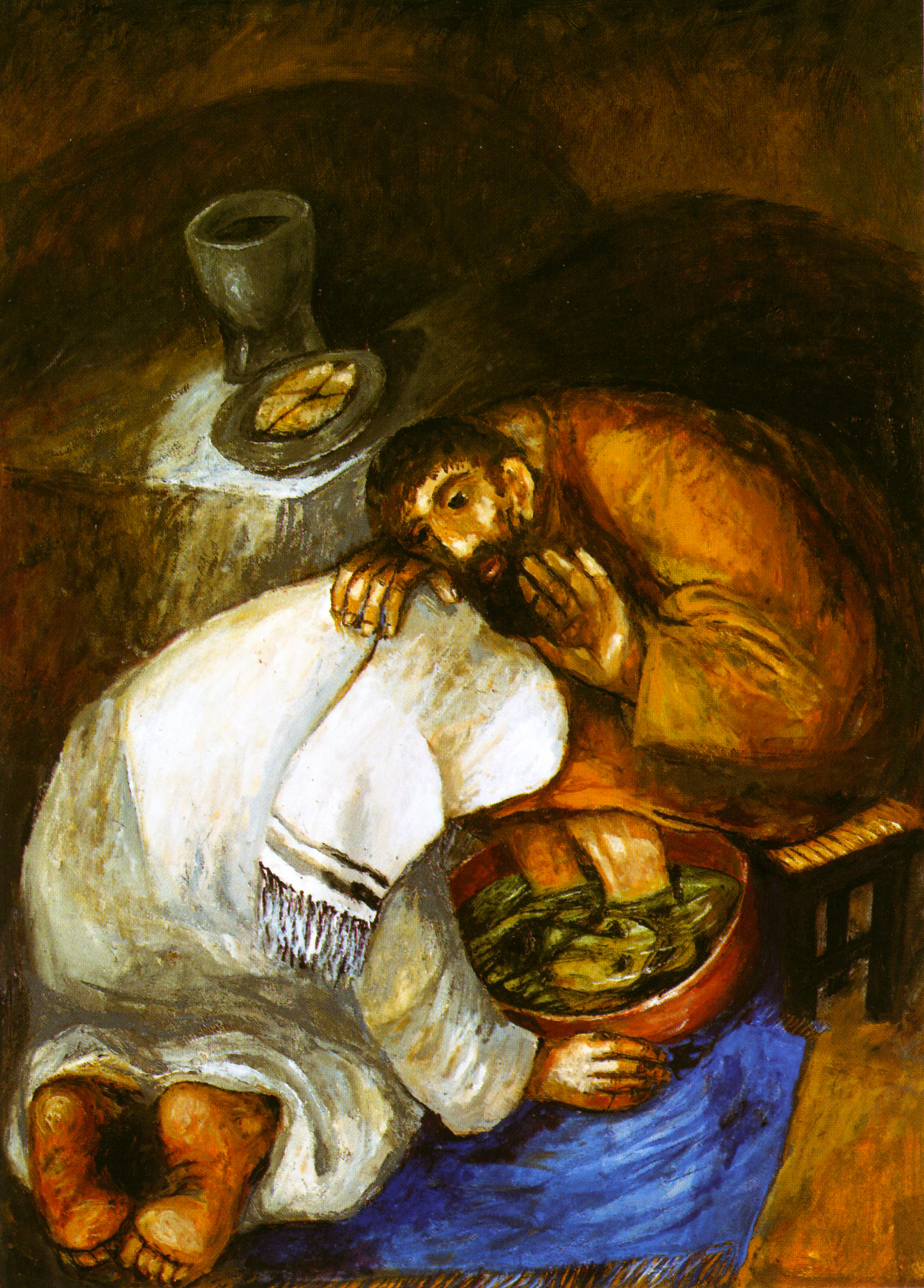
SIEGER KÖDER, Jesus Washes Peter's feet
In his painting Sieger presents the foot washing alongside the elements of bread and wine. Jesus' posture is significant
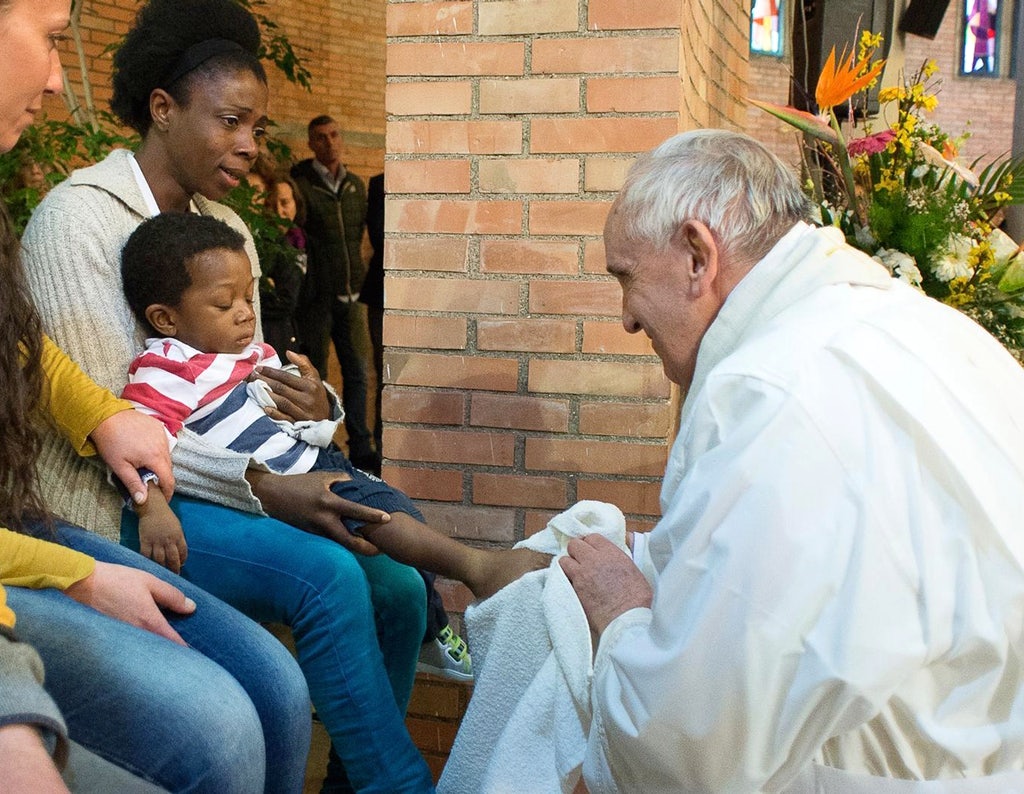
POPE FRANCIS, Ceremony of Washing of feet on Holy Thursday, Rome, Our Father-Church Rebibbia New Complex District Prison.
During the Holy Thursday Mass of the Lord’s Supper. Pope Francis washed the feet of 12 inmates and a toddler who lives with his incarcerated mother. «Jesus does not tire of loving anyone, he loves all of us» so much that he gave his life in order «to give life to us, for each one of us … for you, for you, for me, for them», he said, pointing to the men and women inmates gathered in the “Our Father” chapel in Rome’s Rebibbia Prison complex.
Jesus wash disciples feet - In this scene from The Passion of the Christ, Jesus looks over at the feet of one of the men scourging him...and remembers his time, just the night before, when he washed each disciple's feet. Even Judas... And He said: I have set you an example
Pope explains feet washing ritual- During a special Jubilee audience March 12, Pope Francis explained the significance of Jesus' gesture of washing the feet of his disciples.


